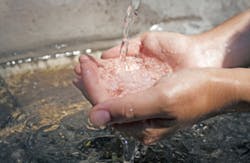Zeolite filter media: Setting a new standard for water filtration
Over the past 50 years, advances in granular filter media water filtration have been achieved by using smaller mesh size sand combined with garnet or garnet/anthracite (multimedia) to achieve a nominal 12 to 15µ rating and to improve bed design and fluidics.
High purity zeolite media is now available that achieves a <5µ nominal rating.
Structure and properties
Mineralogically, there are about 40 known types of natural zeolites (hydrated silicates) of which clinoptilolite is the most common.
Clinoptilolite is classified as a crystalline, aluminum, silicon, oxide mineral (Berkhout 2002; Rempel, 1996). This report describes a high purity 14 x 40 mesh, approximately 55 lb/cu. ft. bulk weight, clinoptilolite (zeolite) from the western US that has a high porosity, high surface area, a micro-crystal structure, and is abrasion resistant.
This zeolite media is classified under 21CFR Part 182.2729 and under 40 CFR Part 180 as GRAS (Generally Recognized As Safe). It is also listed under NSF Standard 61.
Performance and advantages
Since the mid-1970s, lab and field test data reports in the US have indicated that zeolite filtration media has consistently outperformed sand, sand/anthracite and multimedia in both pressure vessels and gravity filtration tests (e.g., Foreman:1985: Johnson & Petersen, 2001 Hansen, 1997:, Johnson et al, 1997; Fuger, 2003).
Generally, the zeolite filter beds have 1.7 to 1.9 times the solids loading capacity/ft3 and superior filtration performance versus multimedia.
Based on more than 100 lab and field tests (2/3 using pressure vessels and 1/3 using gravity beds) since the mid-1990s representing commercial, residential and industrial water filtration projects, it has been concluded that high purity zeolite media is superior to conventional granular media.
Our test results using pressure vessels indicate:
- For solids loading capacity, high purity zeolite surpassed multimedia, sand/anthracite and sand;
- Zeolite more effectively removes fine particles in the 0.5µ to 10µ range that escape conventional media (see Table I).
| Table I. Summary of performance test data for pressure vessels. | ||
| Filter media | Filter rating (nominal) | Solids loading capacity |
| Sand (20 x 40 mesh) | µ | 1X |
| Sand/Anthracite (20 x 40 mesh & Anthracite) | µ | ~1.4X |
| Multimedia | µ | ~1.6X |
| Zeolite (14 x 40 mesh) | <5µ | ~2.6X |
Similar results were observed for gravity beds. Some representative examples of high purity zeolite filter performance are provided below.
River water turbidity:
Zeolite versus multimedia media filtration tests were conducted for fine particle (turbidity) removal from river water. Pressure vessels (18″ diameter) were operated with a service flow rate of 15 gpm/ft2 of bed area for six consecutive days and turbidity (NTU) was measured in the feed and filtrate water.
The zeolite filtrate (product water) average NTU was approximately 1/3 of the multimedia filtrate (see Figure 1), indicating superior fine particle removal by the zeolite.
Prefilter for GAC:
Municipal water supplied to a restaurant contained elevated iron and other fine particles. Cartridge (5µ) filters rapidly loaded and caused reduced water flow to the GAC beds and chiller.
A backwashing zeolite filter (10″ diameter vessel with a 24″ bed depth) was installed and tested by an independent engineer and technical consultant.
The feedwater had 0.1µ to 10µ particles (average SDI or silt density index = 4.3). The zeolite bed effectively removed the iron particles. The product water particles were in the 0.1µ to 2.3µ range, with an average SDI = 0.
RO prefilter:
An electric utility installed a 1,500 gpm water treatment facility with two multimedia filters and RO equipment to produce boiler make-up water. The RO units could not be operated due to filter vessel pressure loss problems and an elevated SDI in the filtrate.
The two multimedia beds were replaced with equivalent bed volumes of 14 x 40 mesh high purity zeolite media and the strict design specifications for the RO feed water have been consistently met for over two years.
Bottled water plant:
A bottled water plant pumped groundwater to four 48″diameter pressure vessels that feed two RO units.
The multimedia reduced the well water SDI by an average 5 percent compared to 45 to 50 percent SDI reduction for the zeolite media.
Cooling tower makeup water:
A major chemical plant facility in South Texas had turbidity problems with river make-up water being used for a cooling tower, The sand/garnet gravity filter inadequately removed turbid particles after rain events.
The sand/garnet was replaced with an equal volume (545.5 ft3) of 14 x 40 mesh zeolite. The zeolite, when operated at the same flow rate (2.5 gpm/ft2), removed greater than 98 percent of the turbidity versus approximately 20 percent for the sand/garnet.
The zeolite has provided superior filtration for two years.
Produced water filtration:
A US oil company wanted to convert unusable oil production water into reusable irrigation water.
The production water was processed for oil/water separation: chemical flocculation; clarification; and ozone oxidation. It was then filtered using two pressure vessels (72″diameter) with high purity zeolite media operating at approximately 12 gpm/ft2.
The filtrate was used directly as feedwater for an RO unit and the product water was recycled as agricultural irrigation water.
Flow rates, backwashing guidelines
For pressure vessels, a 36″ bed depth is generally used with undergravel, plus approximately 50 percent freeboard, similar to multimedia beds.
The optimum service flow rate for pressure vessels ranges from 12 to greater than 20 gpm/ft2 of bed area, depending on the water filtration application.
For example, use 12 gpm/ft2 for RO and GAC pre-filtration; use 15 gpm/ft2 to achieve low turbidity well water, surface water and for industrial projects; and 18 to 20 gpm/ft2 rate to get high water volume for projects with lower filtration requirements.
Since virgin zeolite has “fines” from mine production, it is important to backwash it prior to placing in service. The backwash rule-of-thumb is to achieve 35 percent bed expansion using a backwash rate of 20 gpm/ft2 until the water is clear for new zeolite, and for six minutes for routine operational backwash cycles.
Alternatively, air scour can be used with water to reduce backwash water usage.
References
- Berkhout, Stijn, 2002. Instazeoliter Photochemistry and Photophysics. Report Summary-Internet [email protected].
- Desborough, G.A., 1996, Some chemical and physical properties of clinoptilolite-rich rocks, US Geological Survey Open-File Report 96-265.
- Foreman, G.P. 1985. “Slow Rate Sand Filtration With and Without Clinoptilolite: A Comparison of Water Quality and Filtration Economics.” Masters Thesis, Utah State University, Logan, Utah.
- Fuger 2003. Alternative Filter Media: A Step Above The Rest”. Aqua: Feb Issue, pp 65-70.
- Gilbert, J.S., O”Meara, P.M., Crock, J.G., Wildeman, T.R., and Desborough, G.A., 1999, Adsorption Capabilities of Selected Clinoptiolite-Rich Rocks As It Relates To Mine Drainage Remediation. US Geological Survey Open-Filte Report 99-17.
- Hansen 1997. Engineering Depart-ment, Comparison of Sand and Zeolite Filter Media: Head Loss for Gravity Beds. New Mexico State University, La Cruses, NM. Personnel communication.
- Johnson, T.S.,. Peterson, S., and David, J. (1999). Sorption Removal of Surface Water Turbid Particles As A Filtration Pre-Treatment Method. Filtration “99 Conference, Nov. 2-4, Chicago, IL.
- McNair, D.R., R.C. Simms, D.L. Sorensen and M. Hulbert, 1987. “Schmutzdecke Characterization of Clinoptilolite-Amended Slow Sand Filtration. AWWA 79 (12); p 74-81.
- Pough, F.H. A Field Guide to Rock and Minerals. 4th Edition, Houghton Mifflin Co., Boston, MA 1983.
- Rempel, Siefried, 1996. Zeolite Molecular Traps and Their Use In Preventive Conservation. WAAC Newsletter 18: Number 1, 1-12.
- Virta, R.L., 2002, Zeolites, in US Geological Survey Minerals Yearbook-2002, p. 84.1-84.4.
Tod S. Johnson, Ph.D is president of Filter Flow Technology, Inc., League City, Texas
George A. Desborough, PhD, was senior research geologist, Mineral Resources Program, US Geological Survey, and is now retired.


